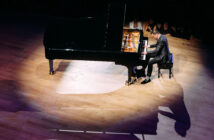An impressive tribute concert to the hit musical Starmania transported the audience — if only in our minds — from a majestic cathedral to a futuristic city of robots and revolutions.
What you missed
Starmania is a popular Canadian-French rock opera set in Monopolis, the capital of the united country Occident. The story tells a story of political revolutionaries versus the rich tycoons, of greed and corruption, and of ever-tragic love. Starmania was created in 1976 by French singer-songwriter Michel Berger and French-Canadian lyricist, Luc Plamondon. Though Berger unfortunately passed away prematurely, Plamondon continued to write music and is also renowned for his lyrics in the 1998 musical Notre Dame de Paris.
Never in a million years did I anticipate seeing the 82-year-old Luc Plamondon in person, much less having the chance to meet and speak with him. Yet there he was in the Cocathédrale Saint-Antoine de Padoue in Longueuil, seated a mere four pews ahead, directly in front of me. Though he was not on stage, there is no doubt that he was the star of the night. Many of his songs from Starmania were further popularized by Celine Dion as she covered them in her 1991 album, Dion chante Plamondon.
The performance itself focused on the songs from the musical, and did not include elaborate costumes, makeup, or sets. Instead, seven singers faced the audience in a row with the Orchestre classique de Montréal led by conductor Jacques Lacombe behind them on the massive altar.
Florence Bourget sang as the double-crossing Sadia, Mishael Eusebio as Ziggy the DJ, Emmanuel Hasler as the businessman Zéro Janvier, Marianne Lambert as TV host Cristal, Hugo Laport as the revolutionary leader Johnny Rockfort, Sophie Naubert as the sex symbol Stella Spotlight, and Suzanne Taffot as Marie-Jeanne the robot waitress. Due to the classically trained opera singers and different instrumentation like a lack of electric guitar, the pieces leaned more operatic in style than the musical’s rock-like recordings and on-stage performances.
The most impressive duo of the night was that of Hasler and Naubert, the businessman and Stella Spotlight. Their respective solos — Le blues du businessman (The Businessman’s Blues) and Le rêve de Stella Spotlight (The Dream of Stella Spotlight) were the only two to earn standing ovations from Plamondon himself, and were incredibly well-deserved. Their voices were beautiful and powerful, and they carried their pieces with grace, anguish, and everything in between. Naubert even burst out with the famously difficult Queen of the Night aria from Mozart’s The Magic Flute, her vocal agility navigating the melismatic passages with skill.
Taffot, in a shimmering metallic dress fit for her robot character, sparkled in her solo Le monde est stone (The World is Stone) and Petite musique terrienne (Little Earth Song). Her high notes in Monopolis A, sounded sharp in comparison with the echoing horns, though her creeping, jazzy, and almost James Bond-esque rendition of Complainte de la serveuse automate (Waitress Automaton’s Lament) was pleasant. Her duets with Eusebio were also sweet, and Eusebio — though playing a more supporting character — sang the harmonies well.
Laporte, as Johnny, impressed with his high notes and falsetto in S.O.S. d’un terrien en détresse (S.O.S. of an Earthling in Distress). His voice was rich, but he was the least animated of the singers; while others gave expressive performances and dramatic gestures, Laporte chose to focus on his voice. He made a decent pairing with Lambert as Cristal, his character’s love interest. Lambert had a sweet and clear voice, particularly in her cry for help in Besoin d’amour (Need for Love) — a slower and more emotionally desperate version than the original pop.
Last but not least, Bourget’s Sadia, the disingenuous ‘friend’ of Johnny’s, was played very well. She stayed in character the whole night, and her amusing facial expressions aligned with every trick she played. Her voice was strong and commanding, her confidence exuberating in Travesti (Transvestite) and Ce soir on danse à Naziland (Tonight We Dance at Naziland). She was, in my opinion, the most convincing and engaging performer of the night.
Gripes
Unfortunately, the acoustics and resulting auditory experience left something to be desired. As the concert was performed in a beautiful cathedral, I did not expect the acoustics to rival any major concert hall. The orchestra, though playing well, drowned out the singers at times. The frequent inability to understand the text was at times offputting and confusing. Brass and percussion occasionally overshadowed and muffled the strings. It appeared that Johnny’s mic was malfunctioning in the very beginning, so many of his earlier lyrics were inaudible.
The sound production improved as the show went on, and those issues carved only a small space out of my overall enjoyment of the performance. Seven talented singers backed by an enthusiastic orchestra resulted in an interesting, entertaining, lyrical rendition of Starmania. Meeting Plamondon was a privilege, and it was equally entertaining to see his reactions to his own music in a different setting and style. It was a rather stellar night, if you catch my drift.
The concert was a one-night event, but Montrealers eager to see Starmania return in its full musical glory — costumes and all — need only wait until August, when the production will grace the Place Bell stage.













